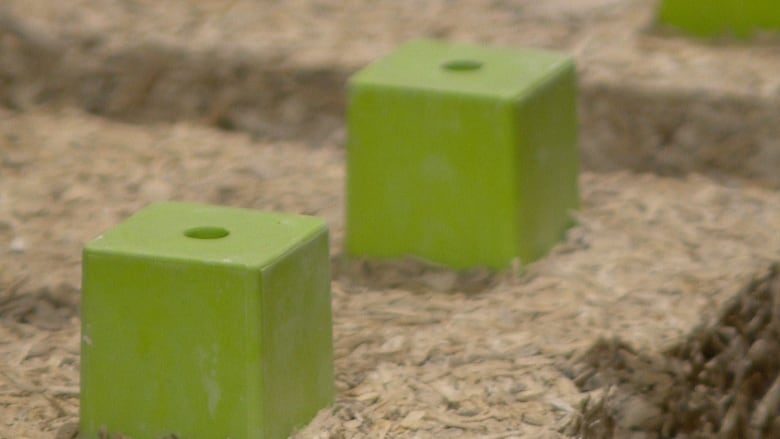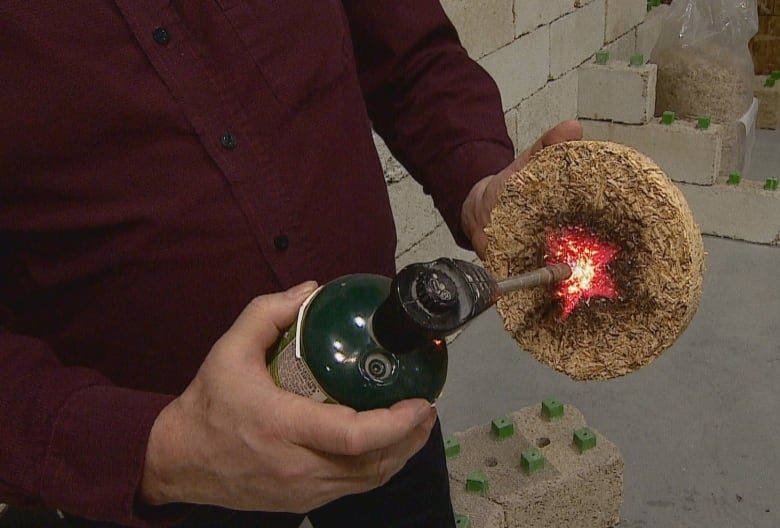
All in all, Terry Radford's new product - with apologies to Pink Floyd - looks to be anything but another brick in a wall.
That's because the president of Just BioFiber, based in Airdrie, Alta., believes it has come up with a hempcrete-based brick that is more than the equal of the usual homebuilding materials.
Radford, president and CEO of Just BioFiber, says his company has found a way to combine hempcrete - the wooden core of the hemp plant - with lime and water to create a building block that he believes has the potential to change the way we build homes. Radford says the product is as environmentally-friendly as it is user-friendly.
"My brother is the guy who actually invented the product. What had happened is he started working with hempcrete and fell in love with the material because it had these great properties," Radford said.
"The benefit to hemp is it's very insulative. It has thermal retention and captures CO2 while it's growing, [at a rate] four times faster than trees, so it's a carbon negative material. We're actually removing carbon from the atmosphere and storing it inside these building materials."
Lego-looking bricks
In addition to being more environmentally-friendly than traditional building materials, the bricks resemble giant Lego building blocks, and offer superior cooling and heating properties, Radford says.
"The No. 1 advantage to having a hemp building is probably the indoor air quality for the occupants," he said.
"It regulates humidity. There's no mould that can grow," he said.
"It's very warm in winter and it's cooler in the summertime - it's basically just an ideal building material for interior comfort and air quality."
"This works really well in hot climates, without the need for air conditioning, and same in cold environments."
The company's hemp blocks are also fire-resistant, Radford says, before pulling out a blowtorch and demonstrating by holding the flame to some hempcrete.
"It does not burn," he said. "It does not contribute to the flame. No smoke. No flame spread. And if you feel the back of the material, as you can tell, there's no thermal transfer. It's very insulated and fire resistant."
What that means, he added, "is that the firefighter going in to a building that's been on fire - it's still safe. You still have structural integrity of the entire building."
What's the catch? You can't use them below grade (underground). The company offers an alternative for below-grade purposes.

"We've developed a manufacturing process where we can get our blocks manufactured on the truck within four days of production," he said.
"It's a much faster process, and when it arrives at the job site, once they're stacked up, you can start applying finishes to the interior and the exterior," he said.
"So it's quicker build times - and [also] you don't have a requirement for high-skilled labour to build them, either."
Price-wise, Radford says, the hempcrete-and-lime bricks are competitive with traditional materials.
"Right now, our cost and speed is about the same as building with stick frame," he said, "but we're a little more expensive than stick frames currently.
"We're about the same as insulated concrete form, but we're a much faster. We're about half of the build time of insulated concrete form because there's no steel, no rebar and no concrete, so you don't have to wait for that to set up.
"Again, as soon as the wall is built, you can start putting your floor or your trusses on top of the wall and keep building. So there's no interruptions to build time."
As far as supply goes, Alberta is hemp heaven, Radford says.
"There's a large amount of hemp being grown, and the Alberta government has been helpful to us," he said, adding that easy access to lime from Exshaw makes the province a good fit for his firm.
It turns out that hemp is a growth crop right across the country, he says.
"That number keeps increasing every year, as hemp becomes more and more popular as a crop with the growers - not only for the fibre, the part that we use, but also for grain and for cannabinoids," he said.
"Those are the real drivers in the marketplace right now, with Canadian farmers - hemp grain, hemp seed - and now with newfound uses for cannabinoids, that becomes the next high value use for hemp."





Reader Comments
In the late 19th century in N.America a new machine had come onto the market that stripped out the fibres, making the use of hemp as profitable as cotton in the manufacture of cloth and paper and that 'fibreglas' Henry used on his car fenders and body parts. Had the powers-that-be not invested so heavily in the petro-chemical and then pharmaceutical industries, Hemp would still be driving our own economies to some extent.
Now, with the rush to reduce CO2, isn't the re-introduction of Hemp the wisest choice? Yet the investments in oil and big pharma. seem to suffocate any new Hemp developments; a hypocrisy not unlike all the other false pretenses we are living under today.
Isn't airtight.
But a good alternative
Forget Hemp --- Marijuana pot weed has way more benefits
[Link]
[Link]